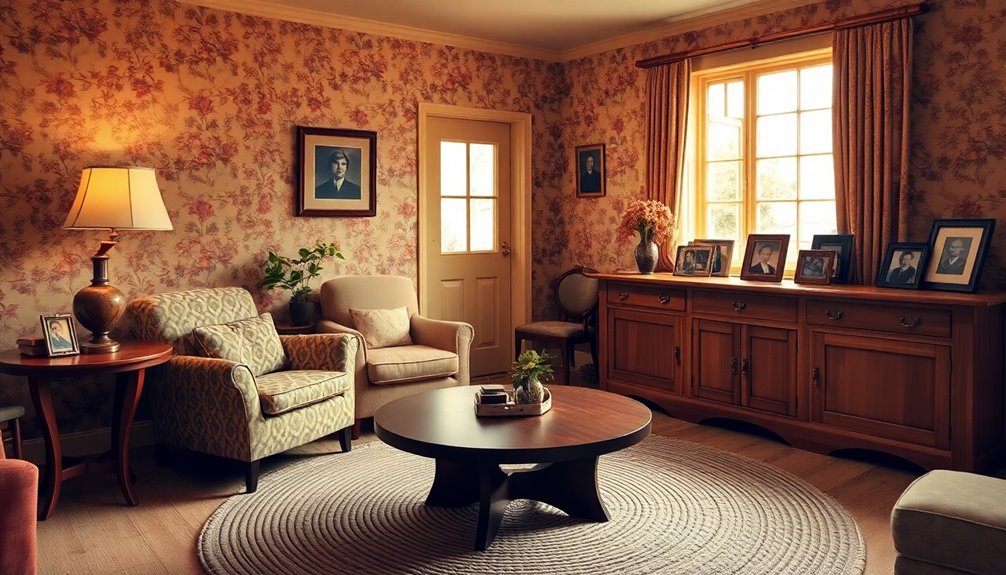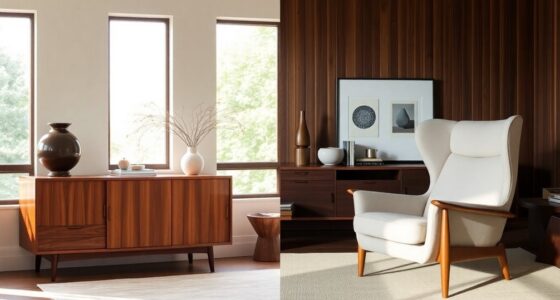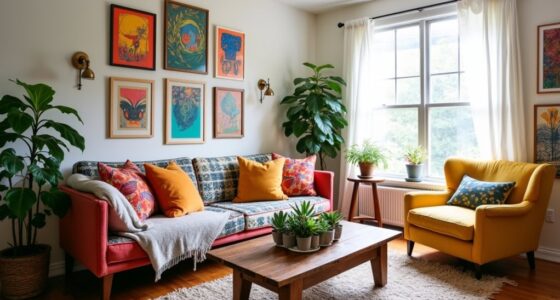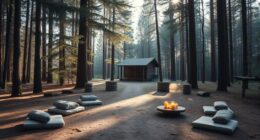In the 1940s, interior design was all about merging nostalgia with functionality. You'd see cozy, stylish homes featuring space-saving furniture like convertible sofas and drop-leaf tables. Bold colors like teal and mustard yellow brought life to kitchens and living areas. The clean lines of mid-century modern design added elegance while maintaining warmth. This period embraced innovative materials and introduced eco-friendly practices. Explore more about how these elements shaped the unique aesthetic of this era.
Key Takeaways
- Post-war optimism shaped 1940s interior design, blending nostalgia with modern aesthetics for a fresh start in home environments.
- Space-saving furniture, like convertible sofas and drop-leaf tables, catered to smaller living spaces while maintaining style and functionality.
- The mid-century modern aesthetic introduced clean lines and organic forms, creating elegant yet cozy living spaces.
- Vibrant colors such as teal and mustard yellow, alongside graphic patterns, added visual interest and energy to interiors.
- Durable materials like chrome and glass, combined with traditional craftsmanship, emphasized functionality and maintenance ease in design.

As the world emerged from the shadows of World War II, the 1940s interior design scene blossomed with a revitalizing blend of American and European influences. You could feel a sense of optimism permeating home environments, as people sought comfort and style in their living spaces. The aesthetic of this era reflected a desire for a fresh start, embracing both nostalgia and modernity. The designs you encountered during this time weren't only visually appealing but also practical, emphasizing functionality in every aspect.
Functionality was crucial in the 1940s, especially with many families adapting to smaller living spaces. You'd notice an increase in space-saving furniture designs that served multiple purposes, such as convertible sofas and drop-leaf tables. These innovative pieces allowed you to maximize your space without sacrificing style.
The clean lines of mid-century modern design began to emerge during this period, merging organic forms with the simplicity that characterized the era. This combination brought a sense of elegance to even the coziest homes.
Color played a significant role in defining the 1940s aesthetic. Bold shades like teal, mustard yellow, and coral became popular choices for kitchens and living areas. These vibrant hues often paired beautifully with graphic patterns in textiles, adding visual interest and energy to your surroundings.
Whether it was a patterned curtain or a geometric throw pillow, these elements infused personality into your home. The integration of these colors and patterns made every room feel inviting, creating an atmosphere that encouraged connection and comfort.
Materials also reflected the modern spirit of the time. Chrome, glass, and laminate were commonly used, highlighting the era's focus on industrial design while still maintaining a cozy atmosphere. These materials not only amplified the modern feel but also provided durability and ease of maintenance, which were essential for busy households.
The combination of traditional craftsmanship with new technology resulted in pieces that stood the test of time, marrying form with function seamlessly. Additionally, the principles of eco-friendly practices in production became increasingly relevant, as designers sought sustainable materials that aligned with modern values.
In essence, the 1940s interior design scene encapsulated a perfect balance of nostalgia and modernity. As you explore this vibrant aesthetic, you'll find that it laid the groundwork for future trends, making it a significant moment in the evolution of home design. Embracing these principles can transform your own living space into a harmonious blend of comfort and style.
Frequently Asked Questions
What Is Functionality in Interior Design?
Functionality in interior design means creating spaces that work for you.
It's about ensuring that your layout and furnishings support your daily activities while keeping things comfortable and efficient.
You'll want to reflect on storage solutions, traffic flow, and multi-purpose furniture that fits your lifestyle.
Accessibility is key too, making sure everyone can enjoy the space.
What Is the Power of Nostalgia in Design?
Imagine walking into a room that feels like a warm hug from your past. The power of nostalgia in design lies in its ability to evoke cherished memories, making spaces feel personal and comforting.
What Is the 70/30 Rule in Interior Design?
The 70/30 rule in interior design suggests you should allocate 70% of your space to foundational elements like furniture and walls, while the remaining 30% focuses on decorative accents.
This balance guarantees that larger pieces don't overshadow smaller decorative items, creating a harmonious environment.
How to Evoke Nostalgia in Design?
Have you ever walked into a room and felt instantly transported back in time?
To evoke nostalgia in your design, incorporate warm earthy paint colors and vintage furniture to create a comforting atmosphere.
Display cherished heirlooms to deepen emotional connections, and use retro patterns in wallpapers and textiles for a lived-in feel.
Conclusion
As you step into the charm of 1940s interior design, you're not just embracing nostalgia; you're inviting a delightful blend of practicality and elegance into your home. This era's unique style whispers of simpler times, where every piece tells a story and every room beckons warmth. By incorporating these timeless elements, you're crafting a haven that honors the past while serving your modern needs. So go ahead, let the allure of the '40s transform your space into a cozy retreat.









